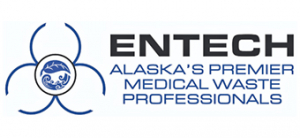Alaska medical waste regulations are managed by the Alaska Department of Environmental Conservation (AKDEC). Medical waste regulations are outlined in Alaska Administrative Code (18 AAC 60.030) as part of more encompassing regulations involving solid wastes. Within this code, medical waste is defined similarly to other jurisdictions as any material that is potentially pathogenic which includes the following types of materials:
- Blood and other bodily fluids;
- Blood soaked bandages and/or compresses;
- Tissues, such as organs or biopsy samples;
- Used and unused hypodermic needles;
- Tattoo and body piercing needles;
- Home kidney dialysis filter, bags, and equipment;
- Lancets and/or other materials used for blood sampling;
- Contaminated gloves or other personal protective equipment (PPE); and
- Culture materials and swabs.
These regulations require individuals involved with these wastes to manage them in a manner which prevents the spread of disease. The regulations also provide the authority for any permitted municipal solid waste landfill or industrial solid waste monofill to accept treated medical waste (medical wastes that are no longer potentially infectious materials) so long as it has been treated according to the manufacturer’s instructions:
- in an autoclave,
- by a decontamination process other than an autoclave,
- or in a medical waste incinerator
The receivers of treated medical waste at permitted facilities have set policies which outline more specific activities that must be followed in order for these materials to ultimately be accepted by these landfills. The municipality of Anchorage’s Department of Solid Waste has established its own medical waste disposal policy which outlines their requirements for any treated medical waste ultimately delivered to their facility for disposal.
This policy applies to any private or public medical, dental or veterinary clinic, office, laboratory, hospital or other facility or service within the Municipality of Anchorage which generates, collects, or processes medical waste with the intent of disposing the waste at the Anchorage Regional Landfill. The purpose of the policy is to:
protect workers, the public, and the environment from exposure to pathogens which could cause diseases. The policy applies to any private or public medical, dental or veterinary clinic, office, facility, laboratory, hospital, or service within the Municipality of Anchorage that generates, collects, or processes medical waste with the intent of disposing the waste at the Anchorage Regional Landfill.
In addition to the Anchorage Municipality, the AKDEC also offers guidance for the proper management of medical waste. As part of previously published material, the AKDEC provides the following recommendations regarding medical waste disposal and selecting a service provider for effective treatment:
-
Reduce the amount of biohazardous waste in the workplace by carefully segregating wastes. Check biohazardous waste container placement. Be sure containers are not located in places where they are likely to be filled with non-infectious or non-biohazardous wastes.
-
Minimize pharmaceutical waste by only accepting quantities of medication samples from drug representatives that will be consumed.
-
When purchasing waste disposal services seek companies that offer alternatives to incineration whenever possible and appropriate.
-
Find out where the biohazardous waste (red bags and needle boxes) are being disposed. Are they being incinerated or autoclaved?
-
Avoid incineration except for wastes which can only be treated by that technology.
Alaska is also one of 21 states that has an approved occupational safety and health program, which is operated by the Alaska Occupational Safety and Health Division (AKOSH) under the Department of Labor and Workforce Development. This program covers aspects of medical waste, including the management of sharps, requirements for containers that hold or store medical waste, labeling of medical waste bags/containers, and employee training. Among other objectives, these standards are designed to protect healthcare workers from the risk of exposure to blood borne pathogens (BBP). The two main offices of AKOSH are located in Anchorage and Juneau and, with the exception of maritime and federal operations, AKOSH maintains workforce safety oversight statewide.
A brief summary of the Alaska State Plan, documentation of AKOSH’s role in Alaska, is included in the Code of Federal Regulations at 29 CFR 1952.12. While AKOSH does manage workforce safety statewide, federal OSHA retains the authority to promulgate, modify, or revoke occupational safety and health standards under Section 6 of the Occupational Safety and Health Act. In the event that federal OSHA resumes enforcement, federal standards will be enforced. Federal OSHA also retains the authority to monitor the Alaska’s State Plan under Section 18(f) of this legislation.
As part of the Alaska State Plan, AKOSH has adopted all federal OSHA standards and incorporates them by reference. Specifically, the department has adopted the following standards with have some relation to medical waste:
- Personal Protective Equipment
- Toxic Substances
- Blood borne Pathogens and Other Infectious Diseases
- Hazard Communication
For medical waste generators operating within Alaska, it is important to understand how these regulations apply to your practice along with the role your service provider plays in keeping your operation compliant.
Contact Entech today or visit our medical waste regulations page if we can help answer any questions you may have about Alaska’s medical waste regulations and how they apply to your practice.
